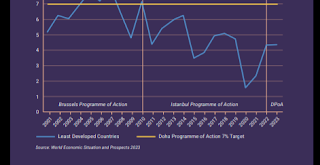Doha and The Least Developed Countries
What are the Least Developed Countries?
The Least Developed Countries (LDCs) are a group of 45 United Nations Member States characterised by their low socio-economic development and high vulnerability to external shocks. These countries are largely agrarian economies that suffer from low investments and productivity.
There are 33 LDCs in Africa, eleven in Asia and the Pacific and one in Latin America. Bhutan was the last LDC to graduate on 13th December, 2023. Previous to that, Vanuatu graduated on 4th December, 2020.
Doha Programme of Action (DPoA)
The Doha Programme of Action (DPoA) for the Decade 2022-2031 was adopted in March 2022 as a successor to the Istanbul Programme of Action.
Full implementation will help the LDCs to address the COVID-19 pandemic and resulting socio-economic impacts; return to a pathway to achieve the Sustainable Development Goals (SDGs); address climate change; and make strides towards sustainable and irreversible graduation.
The final text was adopted during the first part of the LDC5 conference on 17th March 2022 and was endorsed by the General Assembly through resolution ARES/76/258 on 1st April of that year.
The second part took place in Doha between the 5th and 9th of March, 2023. There, world leaders gathered with civil society, the private sector, young people and more to build the plans and partnerships to deliver on the promise and ambition of the DPoA over the following decade.
Progress on the implementation
The key focus areas of the Doha Programme of Action The COVID-19 pandemic overwhelmed the global economy in 2020. 15 million
more people in LDCs were living in extreme poverty in 2023 than in 2019. More than half of all people living in extreme poverty (about 380 million) in 2023 lived in LDCs, and average real GDP growth in LDCs fell sharply from 4.7% in 2019 to 3.4% in 2022 but recovered to 4.4% in 2023, remaining well below the 7% growth target.



.png)
Comments
Post a Comment